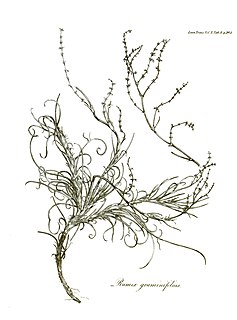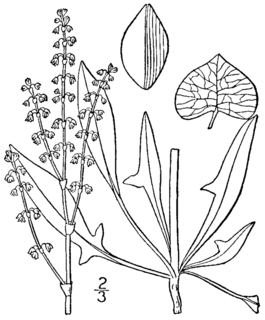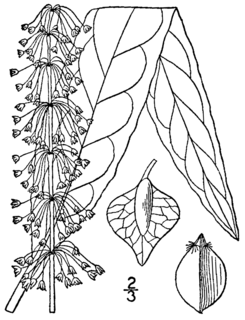
The docks and sorrels, genus Rumex, are a genus of about 200 species of annual, biennial, and perennial herbs in the buckwheat family, Polygonaceae. Members of this genus are very common perennial herbs with a native almost worldwide distribution, and introduced species growing in the few places where the genus is not native.

Calycanthus floridus, or commonly known as the Eastern Sweetshrub, Carolina All Spice, or Spice Bush, is a species of flowering shrub in the family Calycanthaceae. It is identifiable by its dark red flowers and fragrant scent. It is non-invasive and is found in the southeastern United States Region. Its conservation status is G5, indicating it is low-risk.

Rumex maritimus, commonly called golden dock, bristle dock, or seashore dock, is an annual plant species of the genus Rumex. Rumex maritimus grows in Argentina, Burma, Canada, China, and the United States. It is native to Canada and most of the 48 states. The life span of Rumex maritimus is rarely biennial in moist environments. This herb belongs to the family Polygonaceae.

Rumex hypogaeus, commonly known in English as southern threecornerjack, devil's thorn, or double gee, is a herbaceous plant of the Polygonaceae. It is native in South Africa and is an invasive species in Australia & Texas in the USA.

Rumex graminifolius, common name grassleaf sorrel, is a species of the genus Rumex and the knotweed family Polygonaceae.

Rumex salicifolius is a species of flowering plant in the knotweed family known by the common names willow dock and willow-leaved dock. It is native to much of western North America, and more specifically, in southern and central parts of California, and some parts of Arizona and Nevada. It can also be found in parts of Europe as an introduced species and a roadside weed. It is an extremely variable plant which is generally divided into many varieties, some of which may actually be specimens of other species.

Rumex hispanicus, common name maiden sorrel or mountain dock, is a leafy perennial herb in the family Polygonaceae.

Sagittaria platyphylla, the delta arrowhead, broad-leaf arrowhead or delta duck-potato, is a plant species native to the eastern United States. The core of its range extends from central Texas to the Florida Panhandle north to southern Illinois. Isolated populations have been reported from Washington State, Missouri, Kansas, Ohio, Kentucky, Pennsylvania, West Virginia, eastern Virginia, North and South Carolina and eastern Georgia, Nuevo León, Michoacán and Panamá. It has also become a noxious weed in Australia. The plant is an emergent aquatic found in ponds, lakes and slow-moving streams.
Rumex persicarioides is a flowering dicot species in the family Polygonaceae. This species flowers annually in the summer-time but on rare occasions it has been found to be biennial. R. persicarioides is not cultivated for human use and should not be confused with the similarly named genus Persicariae.

Rumex sanguineus, commonly known as bloody dock or red veined dock, is a perennial flowering plant species in the family Polygonaceae. Rumex sanguineus is a dicot and can be observed in Europe with at least two varieties

Rumex bucephalophorus, also known as horned, red, or ruby dock is an annual herbaceous plant that is part of the family Polygonaceae. The scientific name Rumex bucephalophorus was first described and published by Linnaeus in 1753 in Species Plantarum. Other scientific names have also been given to Rumex bucephalophorus such as Bucephalophora aculeata and Lapathum bucephalophorum. R. bucephalophorus is most commonly found in subcoastal or coastal regions, but also are "casual aliens", few and far between, among inland populations. Rumex bucephalophorus is native to the Mediterranean Basin and grows best in areas with little human intervention.
Rumex fueginus is a flowering plant species in the family Polygonaceae. Some common names for Rumex fueginus include Tierra del FuegoGolden dock,American dock, and was formerly known as R. maritimus. The growing season of this plant can last anywhere from 2 to 8 months.

Rumex hastatulus, commonly known as the heartwing sorrel, is an annual flowering plant species in the family Polygonaceae otherwise known as the buckwheat family. It is found spread out through the eastern and southern United States.

Rumex verticillatus, also known as swamp dock, is a species of perennial flowering plant in the family Polygonaceae. Rumex verticillatus is native to, and almost entirely found in, the eastern half of North America. It is common to find this plant in edges of vernal pools and streams in woodlands, swamps, soggy islands in partially shaded areas, marshes, and roadside ditches.
Rumex utahensis is a flowering plant species in the family Polygonaceae. The common name for this species is Utah dock. It is a dicot, perennial herb that is native to the United states, growing only in the West.

Rumex occidentalis is a flowering plant species belonging to the family Polygonaceae. Commonly known as western dock, Rumex occidentalis can be found in parts of Western North America.
Bistorta plumosa is a flowering plant species in the family Polygonaceae, or buckwheat family. Common names for Bistorta Plumosa include meadow bistort. Bistorta plumosa is monoecious, with flowers containing both male and female reproductive parts that are pollinated by insects. Birstorta plumosa flowers annually in the summer months from May to June and can be found in habitats ranging from moist to dry sites and tundra in North America, Alaska, Yukon, the Northwest Territory, and East Asia.
Rumex lapponicus, known commonly as Lapland mountain sorrel is a perennial flowering herb species in the family Polygonaceae. It is commonly found in meadows and rock outcrops, as well as montane, arenicolous, and alluvial habitats.

Rumex cuneifolius is a flowering plant species in the family Polygonaceae.
Rumex fascicularis is a plant from the family Polygonaceae. This specific plant species experiences perennial growth and is originally found in North Carolina. Rumex fascicularis is from the genus Rumex, which are herbs and it is commonly seen growing near swamps, shores of rivers and lakes.













